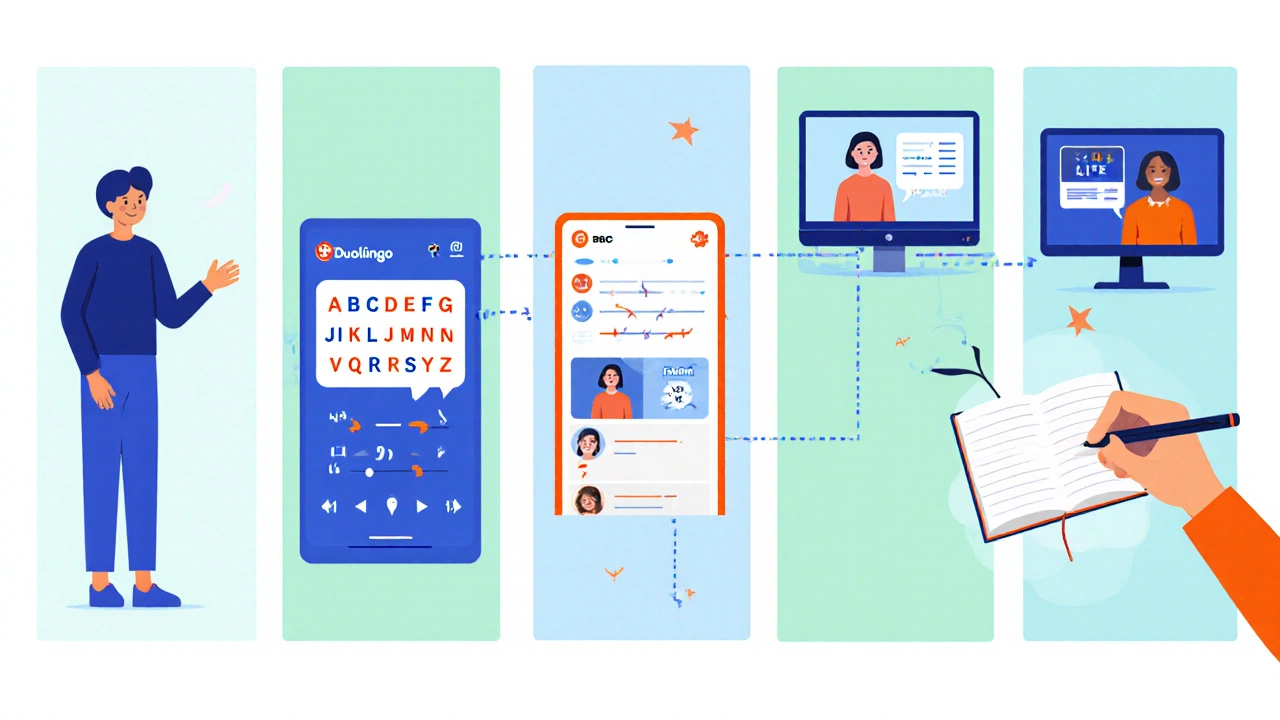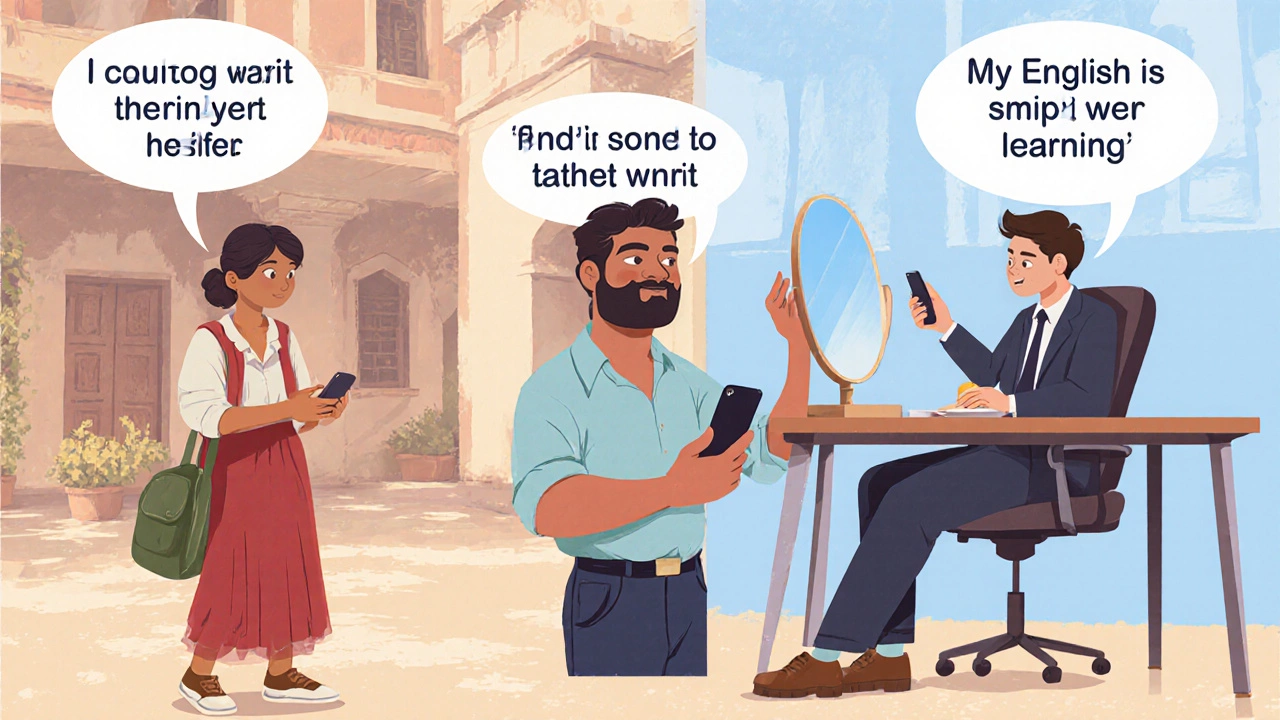Quick Takeaways
- You don’t need to pay for quality speaking practice - apps, podcasts, YouTube, and community groups cover every level.
- Combine a structured app (like Duolingo) with live exchange (ConversationExchange, Tandem) for fastest fluency.
- Use a weekly checklist: warm‑up, focused lesson, speaking out loud, real‑time conversation, review.
- Pick resources that match your schedule - short 5‑minute drills for commuters, longer 30‑minute talks on weekends.
- Track progress with a simple journal; noticing improvement keeps motivation high.
Ever Googled "where can I learn English speaking for free" and felt overwhelmed by the flood of options? You’re not alone. Many learners think high‑quality speaking practice costs money, yet a handful of platforms and community tools deliver real‑world conversation practice at zero price. This guide pulls together the most reliable free resources, shows how to stitch them into a daily routine, and points out common traps so you can finally speak English with confidence - without spending a rupee.
Why Free Resources Can Be Just as Effective
Free doesn’t mean low‑quality. Most of today’s platforms are backed by universities, media giants, or global language‑learning communities that invest heavily in curriculum design. They use the same research‑based methods you’d find in paid courses: spaced repetition, pronunciation scoring, and real‑time feedback. The main difference is the business model - they earn through ads or optional premium upgrades, but the core speaking exercises stay free.
What matters most for speaking fluency is regular, active use. If you practice 10-15 minutes daily, whether on a phone app or with a conversation partner, you’ll see steady improvement. The key is to blend three pillars:
- Input - listening to native speech.
- Output - speaking aloud, even to yourself.
- Interaction - exchanging ideas with real people.
Free resources excel at each pillar, and you can mix‑match them based on your learning style.
Top Free Platforms for Speaking Practice
Below is a quick snapshot of the most popular, completely free tools that focus on speaking. They differ in format (app vs. web), community size, and extra features like pronunciation scoring.
| Platform | Primary Focus | Speaking Feature | Best For |
|---|---|---|---|
| Duolingo - a gamified language app with short speaking drills | All‑level vocabulary & grammar | Voice‑recorded prompts with instant accuracy feedback | Beginners who love bite‑size lessons |
| BBC Learning English - media‑driven lessons from the BBC | Listening & pronunciation | Shadow‑reading videos; transcript recitation | Intermediate learners seeking authentic accents |
| EngVid - free video tutorials by native teachers | Grammar & idioms | Practice sections with "speak now" prompts | Students who prefer structured lessons |
| ConversationExchange - language‑partner matching website | Live conversation | Text, audio, or video calls with native speakers | Learners ready for real‑time dialogue |
| Tandem - mobile app for language exchange | Community chat | Voice notes and video calls with correction features | Busy adults who want on‑the‑go practice |
All five platforms are free to join. You can start with Duolingo for daily drills, then graduate to ConversationExchange or Tandem for live speaking. The combination gives you both structured feedback and authentic interaction.

Community & Language Exchange Options
Speaking to another human is the fastest way to break the “thinking‑in‑translation” habit. Here are the best free community‑driven ways to find a partner.
- ConversationExchange - Register with your city (Bangalore, Delhi, Mumbai, etc.) and filter by age, interests, or native language. Most members prefer a 30‑minute video call once a week.
- Tandem - The app matches you based on your proficiency level and interests. Use the built‑in correction tool: when your partner flags a mistake, the app shows the corrected phrase instantly.
- Meetup - Search for "English Speaking Club" in your region. Many groups meet in cafés or online via Zoom; attendance is usually free and open to all skill levels.
Tip: Always set a clear agenda for each session - e.g., “Describe your weekend plans” - so the conversation stays focused and you get targeted speaking practice.
YouTube Channels & Podcasts for Real‑World Listening
Passive listening isn’t enough; you need to repeat what you hear. Choose channels that encourage you to speak along.
- BBC Learning English - Their "6 Minute English" videos end with discussion questions, perfect for pausing and answering aloud.
- EngVid - Each lesson ends with a short "speak it" segment where the teacher models a sentence and asks you to repeat.
- English with Lucy - Lucy often gives pronunciation drills and asks viewers to practice tongue‑twisters.
For audio‑only learners, try these free podcasts:
- ESL Podcast - Episodes range from 10‑20 minutes, with a transcript you can read and then recite.
- VOA Learning English - Slower speech speed helps you catch every word before you mimic it.

How to Build a Daily Speaking Routine (Step‑by‑Step)
Consistency beats intensity. Follow this 30‑minute template and adapt it to your schedule.
- Warm‑up (3min): Say the alphabet, numbers, or a quick self‑intro. This gets your vocal cords moving.
- App drill (7min): Open Duolingo and complete a speaking lesson. Record your answer and compare the feedback score.
- Input + shadowing (10min): Watch a 5‑minute video from BBC Learning English. Pause after each sentence and repeat it verbatim, matching rhythm and intonation.
- Live practice (8min): Send a voice note on Tandem to a partner, answer the day's prompt, and ask for correction.
- Review (2min): Jot down three new words you used and note any pronunciation mistakes.
Stick to this loop five days a week. On weekends, replace the live practice slot with a 30‑minute group call on ConversationExchange or attend a local Meetup session.
Common Pitfalls & Pro Tips
- Pitfall: Relying only on silent reading. Tip: Speak every new phrase out loud; hearing yourself corrects mistakes faster than mental rehearsal.
- Pitfall: Skipping feedback. Tip: Use apps that score pronunciation (Duolingo, HelloTalk) and ask partners to note one error per session.
- Pitfall: Fear of making mistakes. Tip: Treat errors as data points. Keep a "mistake log" and review it weekly to spot patterns.
- Pitfall: Inconsistent schedule. Tip: Set a daily alarm titled "English Talk Time" - even five minutes beats no practice.
- Pitfall: Listening to only one accent. Tip: Mix British (BBC), American (VOA), and Indian English podcasts to develop flexible ear.
Mini FAQ
Are there truly free English speaking courses that don’t require payment later?
Yes. Platforms like Duolingo, BBC Learning English, EngVid, ConversationExchange, and Tandem all offer unlimited speaking practice without charging. Some may advertise premium tiers, but the core speaking exercises remain free forever.
How much time should I spend each day to see improvement?
Consistent 15‑30 minutes daily is enough for most learners. The routine outlined above (about 30minutes) yields noticeable fluency gains within 6‑8 weeks if you keep the schedule.
What if I don’t have a stable internet connection?
Download videos or podcasts when you have Wi‑Fi, then practice offline. Duolingo also works offline after an initial download, letting you complete speaking drills without internet.
Can I improve my accent for free?
Yes. Use the pronunciation scoring in Duolingo or the “shadowing” method with BBC videos. Record yourself, compare to native speakers, and ask your Tandem partner for specific feedback on vowel sounds.
Do I need a certification to join language‑exchange platforms?
No. All the community sites mentioned - ConversationExchange, Tandem, Meetup - are open to anyone. Just create a profile, state your level, and you’ll be matched with partners who share similar goals.
By mixing structured app drills, authentic listening, and live conversation, you can master English speaking without spending a single rupee. Pick the tools that fit your lifestyle, follow the daily routine, and watch your confidence grow. Happy speaking!

